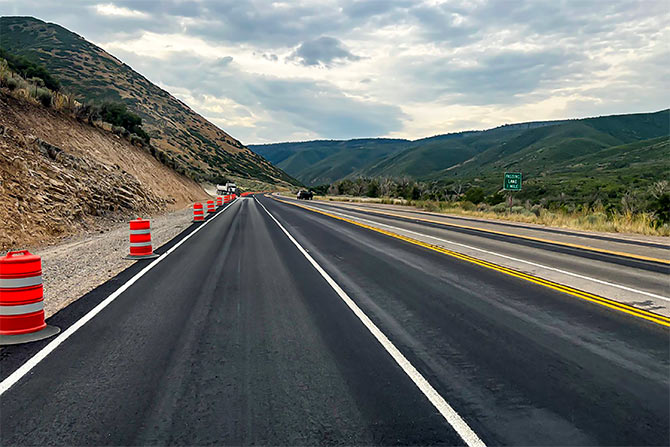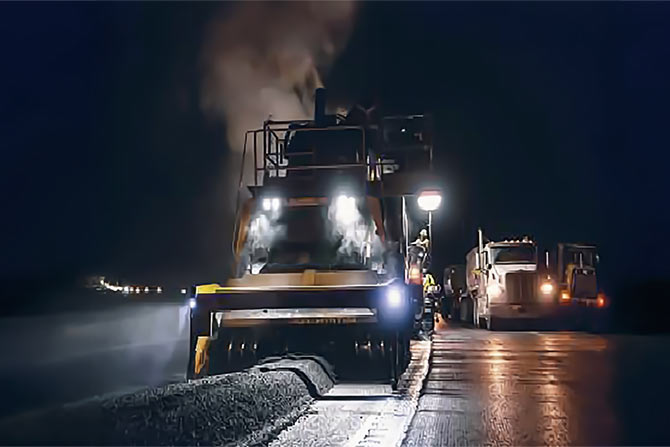Project Location: Heber City, UT
Project Start: October 2023
Project Completion: October 2024
Key Project Team Members:
Jeff Toone, Resident Engineer
Paul Foster, Area Manager
Jared Steele, Construction Tech IV
Shawn Fielding, Project Manager
Dustin Wall, Engineer II
Fidencio Reynaga, Superintendent
Jeff Huffman, Rotational Engineer
Jake Mooyman, Project Engineer
Wayne Cummings, Engineer Tech IV
Michael Ngo, Project Engineer
Andrew Graehl, Transportation Tech II
Micro Surfacing
Intermountain Slurry Seal
Soft Spot Repair
Granite Construction
Pavement Messages/Signs
RoadSafe
Sinusoidal Rumble Strips
Straight Stripe
Pedestrian Ramps
ACME
Shouldering/Guardrail
Rowser
Traffic Control
AAA Barricade
Material Testing
Garco Testing
Project Overview
The UDOT U.S.-40 project addressed several issues between south of downtown Heber City and Daniels Pass on U.S.-40. The existing asphalt needed pavement maintenance treatment and micro surfacing, and with an increase in heavy truck traffic, soft spots had formed that needed patching. Additionally, signs, rumble strips, pavement markings and messages needed to be updated to reflect the increased development in the area.
The project design was to increase the safety of the traveling public. Pedestrian ramps were reconstructed to face minor streets, new signs were installed to reflect changes in road conditions and old signs were replaced to reflect up-to-date standard specifications. This section of U.S.-40 is heavily snow-plowed in the winter months, so this project was designed with micro surfacing for its skid resistance and grooved in paint lines to keep plows from scraping them off.
This project had UDOT’s Price + Time (time component) specification and was estimated for 67 to 123 working days. The project was completed under the minimum of 67 days with a total of 37 working days.
What Makes the Project Unique
This project was unique in its location, half in a rapidly developing Heber City and the other half up Daniels Canyon with its narrow twists and turns and frequent wildlife crossings. Traffic control had to be adaptable to the specific scope of work and location in order to operate safely.
The project team coordinated with three external developers whose projects required lane widening and paint line changes. Our team successfully surveyed the changes before the micro surfacing and seamlessly painted the new lines after the micro surfacing covered the old ones.
In addition to dealing with a variety of traffic, we also faced challenges due to lane closure restrictions. Daytime work, which provided optimal temperatures for micro surfacing, was limited to Monday through Thursday, resulting in a four-shift week. However, by opting for night shifts, we could have lane closures from Sunday night through Friday morning. This choice allowed us to work more shifts and ensured crew safety with less traffic, but the cooler temperatures, often in the 50s, were less ideal for micro surfacing and took longer to set up.
A sinusoidal rumble strip specification was used instead of a UDOT standard rumble strip due to the location. This design reduces the noise outside the vehicle caused by driving over the strips while maintaining the noise inside the vehicle. It was an ideal choice for the residential area, especially with semi-trucks hauling throughout the night.
UDOT standard rumble strips, per STD DWG PV 6B, are 5” long and 6” wide for undivided highways with a 7” gap, creating a 12” cycle. Sinusoidal rumble strips, per the detail below, are 14” wide and are more wave shaped with zero gaps between cuts.
Safety Record
- The U.S.-40 project was originally designed to take place during the day, but after concerns with the traffic arose, UDOT approved a change to conduct construction activities at night. In addition to changing to a night shift schedule, pilot car operations were used for the majority of work to improve the safety of our crews and subcontractors.
- There were zero traveling public accidents.
- Intermountain Slurry Seal worked over 2,000 man-hours with zero injuries.







